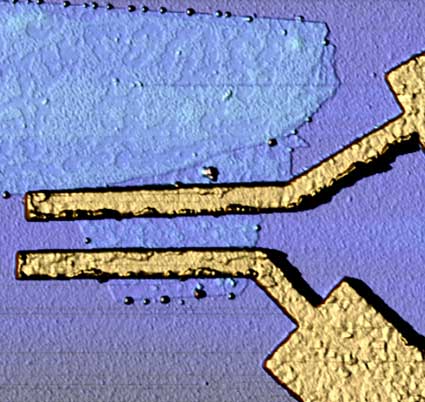| Posted: March 19, 2007 |
Super-carbon: superconductivity and relativity meet in a monolayer of graphite |
|
(Nanowerk News) Until recently, superconductivity and the theory of relativity – two of the last century's greatest discoveries in physics – had very little to do with each other. However, researchers at TU Delft's Kavli Institute for Nanoscience and the FOM Foundation have, for the first time, detected superconducting properties in a material comprised of massless, relativistic electrons. Their device – which consists of graphene attached to superconductors – also functions as a bipolar transistor for superconducting currents. The researchers will publish this scientific breakthrough on 1 March 2007 in the journal Nature.
|
 |
| Image of a layer of graphene attached to superconductors, captured with an atomic force microscope. The distance between each of the superconductors is 300 nanometers. (Image: FOM)
|
|
When you use a pencil to draw a line on a piece of paper, thin layers of graphite remain on the paper. This works so well, because graphite consists of stacks of carbon layers, which easily slide over each other. The graphite remaining on the paper varies in thickness from several thousand layers to only a few. In 2004, researchers in Manchester (UK) were able to successfully isolate a single layer of graphite: graphene. Since then, there has been great interest in this material throughout the world, because of its special electrical properties. In particularly fascinating is the fact that the electrons in graphene seem to be massless. These electrons are not, of course, actually massless. It is their interaction with the atoms in graphene that makes them behave as if they were. This means that they have properties that can only be explained by Einstein's theory of relativity. For instance, the electrons in graphene move at a constant velocity, just as light does.
|
|
Hubert Heersche, Pablo Jarillo-Herrero and their fellow researchers have attached graphene to a superconductor. In a superconductor, the electrical resistance completely disappears at very low temperatures. This means that an electrical current can continue to flow even without a voltage being applied (physicists call this a supercurrent). When graphene - which itself has no superconducting properties - is joined together with a superconductor, it can behave like a superconductor. This effect has been identified in many other non-superconducting materials and is known as the Josephson-effect. The TU Delft researchers have now demonstrated that massless electrons can also carry a supercurrent, and for the first time they were able to measure the relativistic Josephson effect.
|
|
Supercurrent transistor
|
|
The researchers have also demonstrated that graphene can serve as a supercurrent transistor. A transistor is an electrical component in which the current can be regulated by applying a voltage to the so-called 'gate-electrode'. Heersche and colleagues have created a device in which the supercurrent can be regulated by a voltage: a supercurrent transistor.
|
|
A conventional transistor is made from a semiconductor. Graphene is not a semiconductor, but rather a semi-metal. This means that not only the size of the supercurrent can be regulated, but also the type of charge carrier. This can be electrons (with a negative charge) or holes (with a positive charge). The TU Delft team is the first to make a bi-polar supercurrent-transistor.
|
|
Carbon electronics
|
|
The work that has been accepted for publication by Nature is part of a project in which the TU Delft team investigates the electrical properties of graphene. Graphene is being studied intensely throughout the world, because it is believed that graphene can play an important role in the electronics of the future. Large companies too are interested in carbon electronics, because in many respects graphene has superior properties compared to conventional materials, such as silicon. For now, Heersche expects that graphene will mostly continue to be a fascinating material for fundamental research. The striking combination of superconductivity and relativity in graphene constitutes a clear example.
|

